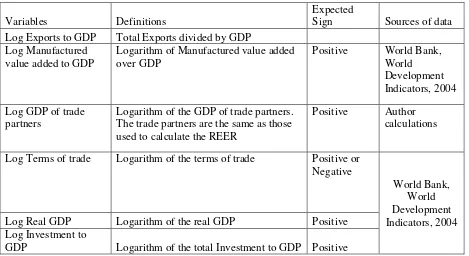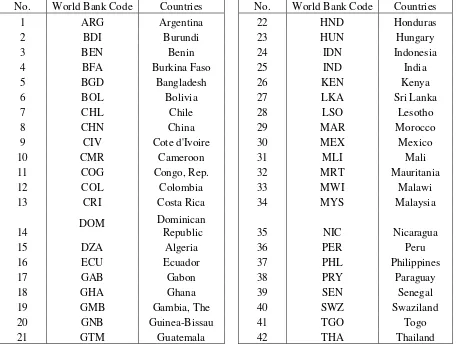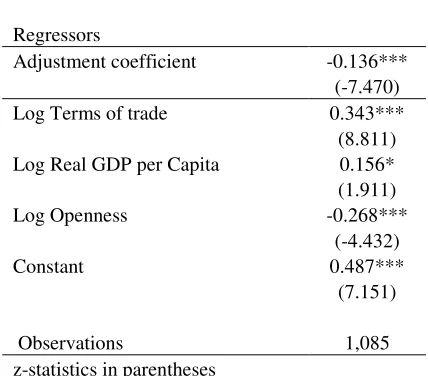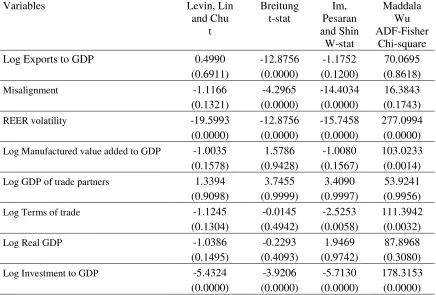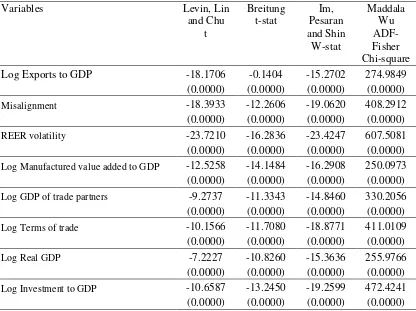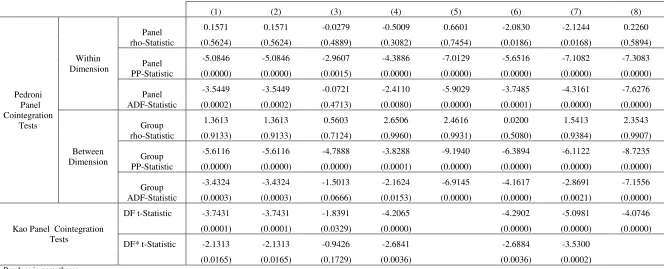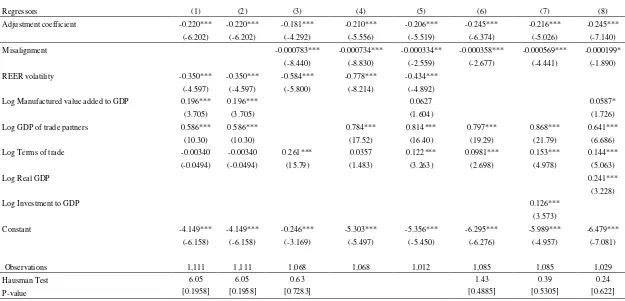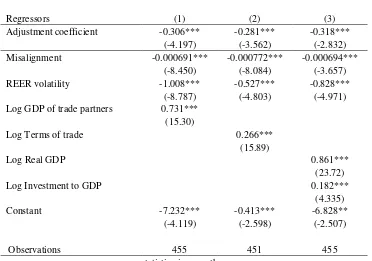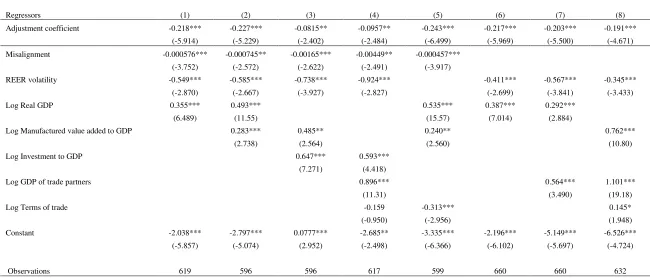The effects of real exchange rate
misalignment and real exchange volatility
on exports
Diallo, Ibrahima Amadou
Clermont University, University of Auvergne, Centre d’Etudes et de
Recherches sur le Développement International, CERDI
30 April 2011
Online at
https://mpra.ub.uni-muenchen.de/32387/
The Effects of Real Exchange Rate
Misalignment and Real Exchange
Volatility on Exports
Diallo Ibrahima Amadou
1April, 2011
Abstract
This paper uses panel data cointegration techniques to study the impacts of real exchange rate misalignment and real exchange rate volatility on total exports for a panel of 42 developing countries from 1975 to 2004. The results show that both real exchange rate misalignment and real exchange rate volatility affect negatively exports. The results also illustrate that real exchange rate volatility is more harmful to exports than misalignment. These outcomes are corroborated by estimations on subsamples of Low-Income and Middle-Income countries.
Keywords: real effective exchange rate; misalignment; volatility; exports; pooled mean group estimator
JEL Classification: F13, F31, F41
1
Introduction
Theoretically, real effective exchange rate (REER) misalignment has a negative effect on
economic performance. In fact, it reduces the export of tradable goods and the profitability of
production. REER misalignment deteriorates domestic investment and foreign direct investment,
consequently growth, by increasing uncertainty. REER misalignment leads also to a reduction in
economic efficiency and a misallocation of resources (Edwards (1988), Cottani, et al. (1990) and
Ghura and Grennes (1993)). Studies have also shown that undervaluation can improve growth.
Levy-Yeyati and Sturzenegger (2007) state that undervaluation increases output and productivity through an expansion of savings and capital accumulation. Rodrik (2009) illustrates that undervaluation rises the profitability of the tradables sector, and leads to an extension of the
share of tradables in domestic value added. Larger profitability encourages investment in the
tradables sector and helps economic growth. Korinek and Serven (2010) illustrates that real exchange rate undervaluation can increase growth through learning-by-doing externalities in the
tradables sector.
Real effective exchange rate (REER) volatility has also a negative impact on economic
performance. In fact, higher REER instability raises uncertainty on the profitability of producing
tradable goods and of long-run investments. Higher REER volatility sends confusing signals to
economic agents (Grobar (1993), Cushman (1993) and Gagnon (1993)). Some authors, like
Aghion et al. (2009), have argued that the impact of exchange rate volatility on economic performance is function of the level of financial development. Others states that the effect of
exchange rate variability on economic performance depends on the complementarity between
Many studies have investigated the empirical link between exchange rate misalignment,
REER volatility and economic performance in general and between REER misalignment and
exports in particular. Cottani et al. (1990), Razin and Collins (1997) and Aghion et al. (2009) show that there exists a negative correlation between REER volatility or REER misalignment
and economic performance. For the link REER misalignment-export, using a panel data of 53
countries Nabli and Véganzonès-Varoudakis (2002) found a negative relationship. The same results were found by Jongwanich (2009) for a sample of Asian developing countries. Sekkat and Varoudakis (2000) found that REER volatility does not have a systematic negative impact on manufactured export while REER misalignment exerts a significant negative influence on export
for a panel of Sub-Saharan African countries. Jian (2007) also found that exchange rate
misalignment has a negative influence on China’s export.
This paper fits in these researches of the links between the REER misalignment, REER
volatility and economic performance. It specifically analyzes the relationship between exchange
rate misalignment, REER volatility and total exports. It distinguishes itself by using panel data
cointegration techniques and a measurement of REER volatility which have not been used in
previous works. The sample studied contains 42 developing countries from 1975 to 2004. We
use panel data cointegration techniques because our time span is too large: 30 years. This raises
the question of the existence of potential unit root in the variables studied and leads to the issue
of cointegration. The application of panel data cointegration techniques has several advantages.
Initially, annual data enable us not to lose information contrary to the method of averages over
subperiods. Then, the addition of the cross sectional dimension makes that statistical tests are
normally distributed, more powerful and do not depend on the number of regressors in the
Pesaran et al. (1999) Pooled Mean Group Estimation of Dynamic Heterogeneous Panels
estimator. The microeconomic panel data methods: random effects, fixed effects, and GMM
oblige the parameters (coefficients and error variances) to be identical across groups, but the
intercept can vary between groups. GMM estimation of dynamic panel models could lead to
inconsistent and misleading long-term coefficients when the period is long. Pesaran et al. (1999)
suggest a transitional estimator that permits the short-term parameters to differ between groups
while imposing equality of the long-run coefficients.
The paper is organized as follow: section 1 presents the econometrics estimations
methods, section 2 analyze the data, section 3 shows how the variables of interests are measured,
section 4 and 5 deal with the panel data tests and main estimations results respectively, section 6
1.
Econometrics models and estimations methods
To estimate the effect of exchange rate misalignment, REER volatility on total exports,
the method of Pooled Mean Group Estimation of Dynamic Heterogeneous Panels of Pesaran et al. (1999) is applied. In this model, the long-run variation of export and other regressors are supposed to be identical for countries but short-run movements are expected to be specific to
each country. The estimated model is an
ARDL
p q, ,...,1 qk
representation of the form:(1)
, ,
1 0 ij
p q
yit ij i t jy Xi t j i it
j j
Where i1, 2,...,Nis the number of groups; t1, 2,...,Tis the number of periods; Xitis the k1vector of regressors;
ij
are the k1 coefficient vectors; ij
are scalars and iis the
fixed effects.
Equation (1) can be rewritten as error correction model of the form:
1 * 1 '* (2), 1 , 1 ,
1 0
i
p q
yit i yi t Xit ij yi t ij Xi t j i it
j j Where 1 1 p i ij j
; 0 / 1
q
i j ij k ik
;
*
1, 2,..., 1 1
p
j p ij m j im
and * 1, 2,..., 1
1 q j q ij im m j .
The parameter iis the error correction term. This parameter is supposed to be significantly negative since it is assumed that the variables return to a long-term equilibrium. The
long-run relationships between the variables are in the vector '
i
. To estimate equation (2)
coefficients to be equal through the groups but forces short-term coefficients and error variances
to be different through the groups. Pesaran et al. (1999) use the maximum likelihood method to estimate the parameters in equation (2) given that this equation is nonlinear. The log-likelihood
function is given by:
2 1 1
( , , ) ln 2 (3)
2
2 1 2 1
N N
T
l i yi i i Hi yi i i
T i i
i
Where i1,...,N;
, 1
y X i i t i i
; Hi IT W W W Wi
i i
i, ITis an identity matrix of
order T and
,..., , , ,...,
, 1 , 1 , 1 , 1
Wi y y Xi X X i t i t p i t i t q
.
The estimated long-run relationship between REER misalignment, REER volatility, the
control variables and exports is:
0 1 2 3 4
5 6 7
( ) ( ) ( )
( ) ( ) ( ) (4)
it it it it it
it it it it
Log EXPGDP MISAL RERVOL Log MVADGDP Log GDPTP Log TOT Log RGDP Log INVGDP
Where i are the long-term parameters, Log EXPGDP( it) is Log Exports to GDP,
it
MISAL is REER misalignment, RERVOLit is REER volatility, Log MVADGDP( it) Log Manufactured value added to GDP, Log GDPTP( it) Log GDP of trade partners, Log TOT( it) Log Terms of trade, Log RGDP( it) Log Real GDP and Log INVGDP( it) Log Investment to GDP. Table 1 gives the definition, expected signs and sources of all variables of the study and Table 2
shows the summary statistics on the variables. If we assume that all variables in equation (4) are
1 0 1 2 3
4 5 6 7
( ) [ ( ) ( )
( ) ( ) ( ) ( )]
+
it i it it it it
it it it it
Log EXPGDP Log EXPGDP MISAL RERVOL Log MVADGDP Log GDPTP Log TOT Log RGDP Log INVGDP
1 2 3 4
5 6 7
( ) ( )
+ ( )+ ( )+ ( ) (5)
i it i it i it i it
i it i it i it it
MISAL RERVOL Log MVADGDP Log GDPTP Log TOT Log RGDP Log INVGDP
The parameter i is the error-correcting speed of adjustment term. As mentioned above,
we expect this parameter to be significantly negative implying that variables return to a long-run
equilibrium.
2.
Data and Variables
To study the effect of REER misalignment and REER volatility on exports, we utilize
annually data from 1975 to 2004 of 42 developing countries. The data are from World
Development Indicators (WDI) 2006, International Financial Statistics (IFS), April, 2006 and
Centre D’études Et De Recherches Sur Le Développement International (CERDI) 2006. Table 3
gives the list of all countries used in the study.
The REER is calculated according to the following formula:
10 (6) / / 1 j CPIi
RER NBER j i
i j j CPI j
Where: / NBER
j i: is the nominal bilateral exchange rate of trade partner j relative to countryi
CPIi: represents the consumer price index of country i (IFS line 64). When the country CPIis
CPI j: corresponds to the consumer price index of trade partner j (IFS line 64). When the country CPIis missing, the growth rate of the GDP deflator is used to feel the data;
j
: stands for trade partner j weight (mean 1999-2003, PCTAS-SITC-Rev.3). Only the first ten
partners are taking (CERDI method). These first ten partners constitute approximately 70% of
trade weights. The weights used to generate the REER are (Exports + Imports) / 2 excluding oil countries. Weights are computed at the end of the period of study in order to focus on the
competitiveness of the most recent years.
An increase of the REER indicates an appreciation and, hence a potential loss of
competitiveness.
3.
Measurement of variables of interest
In this section, we will present how the variables of interest are calculated.
3.1.Measurement of REER Misalignment
Before calculating the REER misalignment, we first compute the equilibrium real
exchange rate (EREER). The economic literature on exchange rate states that REER is affected
by its determinants called “fundamentals” (Williamson (1994), Edwards (1998)). We use the PMG estimator to estimate the relationship between REER and its fundamentals. The long-run
estimated equation is:
0 1 2 3
( it) ( it) ( it) ( it) it (7)
Where Log REER( it) is the logarithm of real effective exchange rate, Log TOT( it)the log of terms of trade, Log GDPCAP( it) the log of real GDP per capita and Log OPEN( it)is the log of export and import over GDP.
We expect that a rise in terms of trade ameliorates trade balance, the income effect
dominating the substitution effect, hence 1 is expected to be positive. GDP per capita captures
the Balassa-Samuelson effect which states that productivity increases faster in tradable than in non-tradable sectors. This phenomenon augments wages in the tradable sector, consequently
wages in the non-tradable sector. This implies an increase in domestic inflation and an
appreciation of the REER. Hence we expect 2 to be positive. Restricted trade has a downward
effect on the relative price of tradable to non-tradable goods, leading therefore to an appreciation
of the REER. Thus 3 is supposed to be negative.
If we assume that all variables in equation (7) are I(1) and cointegrated then it is I(0).
The error correction representation of equation (7) is given by:
1 0 1 2 3
1 2 3
( ) ( ) ( ) ( ) ( )
+ ( ) ( ) ( ) (8)
it i it it it it
i it i it i it it
Log REER Log REER Log TOT Log GDPCAP Log OPEN
Log TOT Log GDPCAP Log OPEN
The parameter i is the error-correcting speed of adjustment term. As mentioned above,
we expect this parameter to be significantly negative implying that variables return to a long-run
equilibrium. Of particular importance are the parameters i which capture the long-term
relationship between REER and the fundamentals. The results of the estimation of equation (8)
Table 4 shows that all parameters have the expected signs and are statistically significant.
In particular the Adjustment coefficient is negative. This relationship between REER and the
fundamentals is also cointegrated. For example the Pedroni (1999) panel data cointegration Panel-PP statistic and Group PP-statistic are respectively 0.0121 and 0.0178. This result and the
negative sign of the Adjustment coefficient mean that the long-run value of REER stays around
its equilibrium value. After estimating equation (8), we multiply the parameters i by the
corresponding three year moving average of the corresponding fundamental. This result gives us
the equilibrium REER (EREER). Then REER misalignment is then computed according to the
following formula:
( )
1 (9)
( ) it it it Log REER Misal Log EREER
In equation (9), a positive value of Misalit represents an overvaluation.
3.2.Measurement of REER Volatility
We compute real exchange rate volatility using ARCH family methods. Specifically we
apply the asymmetric EGARCH (1, 1). The asymmetry implies that positive values of residuals
have a different effect than negative ones. This is formulated as below:
1 0
1
2 2 1
t 0 1 2 1 1 1 2
1 1
( ) ( )
( ) ( ) (10)
t t t
t t
t
t t
Log REER Log REER
Log Log
Where t are distributed as
2 t
(0, )
N , 2
t
the variance of the regression model’s
disturbances, i the ARCH parameters, 1 the GARCH parameter, 1 the asymmetric EGARCH
produce higher variances in the near future. We measure the exchange rate volatility as the
square root of the variance of the regression model’s disturbances.
4.
Panel data tests
In this section, we will successively present the panel unit root tests and the cointegration
tests.
4.1.Panel Unit Root Tests
Table 5 gives the results of the unit root tests for all variables expressed in level. In all
tests, the null hypothesis is that the series contains a unit root, and the alternative is that the series
is stationary. The Levin, Lin and Chu and the Breitung tests make the simplifying assumption that the panels are homogenous while the other tests assume that the panels are heterogeneous.
Excluding Log Investment to GDP and REER volatility which are stationary2, the tests show that
all the other variables may contain unit root. Moreover Table 6 illustrates that these other
variables are potentially I(1). This last result leads us to the issue of cointegration among these variables.
4.2.Panel Cointegration Tests
Table 7 shows the panel data cointegration tests for the equations used in the main
estimation results3. Among the panel cointegration tests, we utilize the Pedroni (1999) and Kao
2
The Misalignment variable can also be considered as stationary because two tests out of four show that it is stationary.
3
(1999) panel cointegration tests. In the Pedroni (1999) tests, the first three tests present the within dimension while the others give the between dimension. For the Kao (1999) tests, only the Dickey-Fuller type tests are shown. In all these tests, the Null Hypothesis is that there is No
cointegration. Overall, the results illustrates that there exist a cointegration relationship for all
equations.
5.
Estimation Results
Table 8 presents the main estimation of the long-term coefficients that interest us. We
know that the PMG estimator constrains the long-run elasticities to be equal across all panels.
This PMG estimator is efficient and consistent while the Mean Group (MG) estimator, which
assumes heterogeneity in both short-run and long-run coefficients, is consistent when the
restrictions are true. If the true model is heterogeneous, the PMG estimator is inconsistent while
the MG estimator is consistent. We run a Hausman test to test for the difference between these two models in our sample of study. The P-values for the Hausman test in Table 8 show that we do not reject the Null hypothesis that the efficient estimator, the PMG estimator, is the desired
one. The speed of adjustment parameter is negative and highly significant in all regressions and
is approximately stable in magnitude. As mentioned above, this result suggests that the variables
return to a long-run equilibrium.
All eight equations in Table 8 illustrate that REER misalignment and REER volatility are
statistically significant and have the expected signs. We notice that the magnitude of REER
misalignment is too low compared to that of REER volatility. This suggests that REER volatility
volatility is very high. Referring to regression 4, an increase in REER volatility by one standard
deviation reduces the ratio of exports to GDP by an amount approximately equivalent to 24%.
These results corroborate those found by several studies like Ghura and Grennes (1993) and
Grobar (1993). The absolute value of the REER volatility coefficient diminishes by half when we introduce the logarithm of GDP of trade partners in regressions 1, 2 and 5, suggesting that the
effect of volatility on exports may pass through the GDP of trade partners.
The results also highlight that exports are positively influenced by manufactured value added
to GDP, GDP of trade partners, Real GDP and Investment to GDP. The Terms of trade, when they
are significant, are also positively related to exports. The positive value of the coefficient of GDP of
trade partners means that when the trade partners experience high growth, this results in a pulling
effect on the exports of the home country. The positive effect of Real GDP and Investment to GDP
means that exports increase when the productive capacity of a country rises.
6.
Robustness Analysis
Table 9 and 10 give the estimations of the effects of REER misalignment and REER
volatility on exports for the low income and middle income developing countries respectively.
The results in the two table show that both REER misalignment and REER volatility affect
negatively exports. This confirms the findings of our main estimations results. Also as in the
main estimations, we observe that REER volatility has is more harmful to exports than
Conclusion
We studied the effects of REER misalignment and REER volatility on exports for 42
developing countries from 1975 to 2004. Using new developments on panel data cointegration
techniques, we found that both REER misalignment and REER volatility have a strong negative
impact of exports. But the effect of REER misalignment is smaller than that of REER volatility.
The impact of REER volatility is very high: an increase in REER volatility by one standard
deviation reduces the ratio of exports to GDP by an amount approximately equivalent to 24%.
Although the results found were informative, some caveats remain. First, we did not
analyze the effect of REER misalignment and REER volatility on manufactured exports and for
developed countries. Second, the fact that REER misalignment is a generated regressor could
cause some bias in the estimation results, especially in the standards errors of the regressions.
From policy perspectives, the results show that macroeconomic instability, in particular
exchange rate volatility could have negative impacts on exports and that efforts made to reduce
References
Aghion, P., Bacchetta, P., Ranciere, R. and Rogoff, K.: 2009, Exchange Rate Volatility and Productivity Growth: The Role of Financial Development, Journal of Monetary Economics 56 (4), 494–513.
Cottani, J. A., Cavallo, D. F. and Khan, M. S.: 1990, Real Exchange Rate Behavior and Economic Performance in LDCs. Economic Development and Cultural Change 39. Cushman, D. O.: 1993, The Effects of Real Exchange Rate Risk on International Trade. Journal
of International Economics 15.
Edwards, S.: 1988, Exchange Rate Misalignment in Developing Countries, Baltimore: The Johns Hopkins University Press.
Edwards, S.: 1998, Capital Flows, Real Exchange Rates, and Capital Controls: Some Latin American Experiences, NBER Working Papers 6800.
Eichengreen, B.: 2008, The Real Exchange Rate and Economic Growth, Working Paper No. 4.
Commission on Growth and Development, World Bank, Washington, Dc.
Gagnon, J. E.: 1993, Exchange Rate Variability and the Level of International Trade. Journal of International Economics 34(3-4).
Ghura, D. and Grennes, T. J.: 1993, The Real Exchange Rate and Macroeconomic
Performances in Sub-Saharan Africa, Journal of Development Economics 42.
Ghura, D. and Grennes, T. J.: 1993, The Real Exchange Rate and Macroeconomic
Performances in Sub-Saharan Africa. Journal of Development Economics 42.
Grobar, L. M.: 1993, The Effect of Real Exchange Rate Uncertainty on LDC Manufactured Exports. Journal of Development Economics 14.
Grobar, L. M.: 1993, The Effect of Real Exchange Rate Uncertainty on LDC Manufactured Exports, Journal of Development Economics 14.
Jian, L.: 2007, Empirical study on the influence of RMB exchange rate misalignment on China’s export-Based on the perspective of dualistic economic structure, Front. Econ. China 2(2), 224–236.
Jongwanich, J.: 2009, Equilibrium Real Exchange Rate, Misalignment, and Export Performance in Developing Asia, ADB Economics Working Paper Series No. 151.
Kao, C.: 1999, Spurious Regression and Residual-Based Tests for Cointegration in Panel Data,
Korinek, A. and Serven, L.: 2010, Undervaluation through Foreign Reserve Accumulation: Static Losses, Dynamic Growth, Policy Research Working Paper 5250, World Bank, Washington, DC.
Levy-Yeyati, E. and Sturzenegger, F.: 2007, Fear of Appreciation, Policy Research Working Paper 4387, World Bank, Washington, DC.
Nabli, M. K. and Véganzonès-Varoudakis, M-A.: 2002, Exchange Rate Regime and
Competitiveness of Manufactured Exports: The Case of MENA Countries, Working Paper, The World Bank.
Pedroni, P.: 1999, Critical Values for Cointegration Tests in Heterogeneous Panels with Multiple Regressors, Oxford Bulletin of Economics and Statistics 61, 653–70.
Pesaran, M. H., Shin, Y. and Smith, R. P.: 1999, Pooled mean group estimation of dynamic heterogeneous panels, Journal of the American Statistical Association 94, 621-634.
Razin, O. and Collins, S. M. A.: 1997, Real Exchange Rate Misalignments and Growth, NBER
Working Paper no. 6174.
Rodrik, D.: 2009, The Real Exchange Rate and Economic Growth, In Brookings Papers on Economic Activity, Fall 2008, ed. D. W. Elmendorf, N. G. Mankiw, and L. H. Summers, 365–412. Washington, DC: Brookings Institution.
Sekkat, K. and Varoudakis, A.: 2000, Exchange rate management and manufactured exports in
Sub-Saharan Africa, Journal of Development Economics 61 (2000), 237–253.
Table 1: Definitions and methods of calculation of the variables
Variables Definitions
Expected
Sign Sources of data
Log Exports to GDP Total Exports divided by GDP
Log Manufactured value added to GDP
Logarithm of Manufactured value added over GDP
Positive World Bank, World Development Indicators, 2004
Log GDP of trade partners
Logarithm of the GDP of trade partners. The trade partners are the same as those used to calculate the REER
Positive Author
calculations
Log Terms of trade Logarithm of the terms of trade Positive or Negative
World Bank, World Development Indicators, 2004
Log Real GDP Logarithm of the real GDP Positive
Log Investment to
GDP Logarithm of the total Investment to GDP Positive
Table 2: Summary statistics on variables
Variables Obs. Mean Std. Dev. Min Max
Log Exports to GDP 1259 -1.4201 0.6245 -3.5422 0.2184
Misalignment 1136 23.2513 896.0622 -8108.7380 27431.8100
REER volatility 1241 0.1531 0.3056 0.0003 7.1438
Log Manufactured value added to GDP 1185 -1.9430 0.4992 -3.6892 -0.8988
Log GDP of trade partners 1260 30.3331 1.1001 26.5335 32.3573
Log Terms of trade 1249 0.0517 0.2627 -0.9333 1.8050
Log Real GDP 1260 22.9255 1.9825 18.5565 28.1704
[image:18.612.79.537.432.570.2]Table 3: List of 42 countries
No. World Bank Code Countries No. World Bank Code Countries
1 ARG Argentina 22 HND Honduras
2 BDI Burundi 23 HUN Hungary
3 BEN Benin 24 IDN Indonesia
4 BFA Burkina Faso 25 IND India
5 BGD Bangladesh 26 KEN Kenya
6 BOL Bolivia 27 LKA Sri Lanka
7 CHL Chile 28 LSO Lesotho
8 CHN China 29 MAR Morocco
9 CIV Cote d'Ivoire 30 MEX Mexico
10 CMR Cameroon 31 MLI Mali
11 COG Congo, Rep. 32 MRT Mauritania
12 COL Colombia 33 MWI Malawi
13 CRI Costa Rica 34 MYS Malaysia
14 DOM
Dominican
Republic 35 NIC Nicaragua
15 DZA Algeria 36 PER Peru
16 ECU Ecuador 37 PHL Philippines
17 GAB Gabon 38 PRY Paraguay
18 GHA Ghana 39 SEN Senegal
19 GMB Gambia, The 40 SWZ Swaziland
20 GNB Guinea-Bissau 41 TGO Togo
Table 4: Estimation of Equilibrium Real Exchange Rate (EREER)
Dependent Variable: Log(REER)
Regressors Adjustment coefficient -0.136***
(-7.470)
Log Terms of trade 0.343*** (8.811) Log Real GDP per Capita 0.156* (1.911) Log Openness -0.268***
(-4.432) Constant 0.487***
(7.151)
Observations 1,085 z-statistics in parentheses
Table 5: Panel unit root tests (Level of variables)
Variables Levin, Lin
and Chu t
Breitung t-stat
Im, Pesaran and Shin
W-stat
Maddala Wu ADF-Fisher
Chi-square
Log Exports to GDP 0.4990 -12.8756 -1.1752 70.0695
(0.6911) (0.0000) (0.1200) (0.8618)
Misalignment -1.1166 -4.2965 -14.4034 16.3843
(0.1321) (0.0000) (0.0000) (0.1743)
REER volatility -19.5993 -12.8756 -15.7458 277.0994
(0.0000) (0.0000) (0.0000) (0.0000)
Log Manufactured value added to GDP -1.0035 1.5786 -1.0080 103.0233
(0.1578) (0.9428) (0.1567) (0.0014)
Log GDP of trade partners 1.3394 3.7455 3.4090 53.9241
(0.9098) (0.9999) (0.9997) (0.9956)
Log Terms of trade -1.1245 -0.0145 -2.5253 111.3942
(0.1304) (0.4942) (0.0058) (0.0032)
Log Real GDP -1.0386 -0.2293 1.9469 87.8968
(0.1495) (0.4093) (0.9742) (0.3080)
Log Investment to GDP -5.4324 -3.9206 -5.7130 178.3153
(0.0000) (0.0000) (0.0000) (0.0000)
Table 6: Panel unit root tests (First Difference of variables)
Variables Levin, Lin
and Chu t
Breitung t-stat
Im, Pesaran and Shin
W-stat
Maddala Wu ADF-Fisher Chi-square
Log Exports to GDP -18.1706 -0.1404 -15.2702 274.9849
(0.0000) (0.0000) (0.0000) (0.0000)
Misalignment -18.3933 -12.2606 -19.0620 408.2912
(0.0000) (0.0000) (0.0000) (0.0000)
REER volatility -23.7210 -16.2836 -23.4247 607.5081
(0.0000) (0.0000) (0.0000) (0.0000)
Log Manufactured value added to GDP -12.5258 -14.1484 -16.2908 250.0973
(0.0000) (0.0000) (0.0000) (0.0000)
Log GDP of trade partners -9.2737 -11.3343 -14.8460 330.2056
(0.0000) (0.0000) (0.0000) (0.0000)
Log Terms of trade -10.1566 -11.7080 -18.8771 411.0109
(0.0000) (0.0000) (0.0000) (0.0000)
Log Real GDP -7.2227 -10.8260 -15.3636 255.9766
(0.0000) (0.0000) (0.0000) (0.0000)
Log Investment to GDP -10.6587 -13.2450 -19.2599 472.4241
(0.0000) (0.0000) (0.0000) (0.0000)
Table 7: Panel data cointegration tests
(1) (2) (3) (4) (5) (6) (7) (8)
Pedroni Panel Cointegration
Tests
Within Dimension
Panel rho-Statistic
0.1571 0.1571 -0.0279 -0.5009 0.6601 -2.0830 -2.1244 0.2260
(0.5624) (0.5624) (0.4889) (0.3082) (0.7454) (0.0186) (0.0168) (0.5894)
Panel PP-Statistic
-5.0846 -5.0846 -2.9607 -4.3886 -7.0129 -5.6516 -7.1082 -7.3083
(0.0000) (0.0000) (0.0015) (0.0000) (0.0000) (0.0000) (0.0000) (0.0000)
Panel ADF-Statistic
-3.5449 -3.5449 -0.0721 -2.4110 -5.9029 -3.7485 -4.3161 -7.6276
(0.0002) (0.0002) (0.4713) (0.0080) (0.0000) (0.0001) (0.0000) (0.0000)
Between Dimension
Group rho-Statistic
1.3613 1.3613 0.5603 2.6506 2.4616 0.0200 1.5413 2.3543
(0.9133) (0.9133) (0.7124) (0.9960) (0.9931) (0.5080) (0.9384) (0.9907)
Group PP-Statistic
-5.6116 -5.6116 -4.7888 -3.8288 -9.1940 -6.3894 -6.1122 -8.7235
(0.0000) (0.0000) (0.0000) (0.0001) (0.0000) (0.0000) (0.0000) (0.0000)
Group ADF-Statistic
-3.4324 -3.4324 -1.5013 -2.1624 -6.9145 -4.1617 -2.8691 -7.1556
(0.0003) (0.0003) (0.0666) (0.0153) (0.0000) (0.0000) (0.0021) (0.0000)
Kao Panel Cointegration Tests
DF t-Statistic -3.7431 -3.7431 -1.8391 -4.2065 -4.2902 -5.0981 -4.0746
(0.0001) (0.0001) (0.0329) (0.0000) (0.0000) (0.0000) (0.0000)
DF* t-Statistic -2.1313 -2.1313 -0.9426 -2.6841 -2.6884 -3.5300
(0.0165) (0.0165) (0.1729) (0.0036) (0.0036) (0.0002)
P-values in parentheses.
Table 8: Panel data cointegration estimation results
Dependent Variable: Log Exports to GDP
Regressors (1) (2) (3) (4) (5) (6) (7) (8)
Adjustment coefficient -0.220*** -0.220*** -0.181*** -0.210*** -0.206*** -0.245*** -0.216*** -0.245***
(-6.202) (-6.202) (-4.292) (-5.556) (-5.519) (-6.374) (-5.026) (-7.140)
Misalignment -0.000783*** -0.000734*** -0.000334** -0.000358*** -0.000569*** -0.000199*
(-8.440) (-8.830) (-2.559) (-2.677) (-4.441) (-1.890)
REER volatility -0.350*** -0.350*** -0.584*** -0.778*** -0.434***
(-4.597) (-4.597) (-5.800) (-8.214) (-4.892)
Log Manufactured value added to GDP 0.196*** 0.196*** 0.0627 0.0587*
(3.705) (3.705) (1.604) (1.726)
Log GDP of trade partners 0.586*** 0.586*** 0.784*** 0.814*** 0.797*** 0.868*** 0.641***
(10.30) (10.30) (17.52) (16.40) (19.29) (21.79) (6.686)
Log Terms of trade -0.00340 -0.00340 0.261*** 0.0357 0.122*** 0.0981*** 0.153*** 0.144***
(-0.0494) (-0.0494) (15.79) (1.483) (3.263) (2.698) (4.978) (5.063)
Log Real GDP 0.241***
(3.228)
Log Investment to GDP 0.126***
(3.573)
Constant -4.149*** -4.149*** -0.246*** -5.303*** -5.356*** -6.295*** -5.989*** -6.479***
(-6.158) (-6.158) (-3.169) (-5.497) (-5.450) (-6.276) (-4.957) (-7.081)
Observations 1,111 1,111 1,068 1,068 1,012 1,085 1,085 1,029
Hausman Test 6.05 6.05 0.63 1.43 0.39 0.24
P-value [0.1958] [0.1958] [0.7283] [0.4885] [0.5305] [0.622]
Table 9: Estimation Results for Low-Income Countries
Dependent Variable: Log Exports to GDP
Regressors (1) (2) (3) Adjustment coefficient -0.306*** -0.281*** -0.318*** (-4.197) (-3.562) (-2.832) Misalignment -0.000691*** -0.000772*** -0.000694***
(-8.450) (-8.084) (-3.657) REER volatility -1.008*** -0.527*** -0.828***
(-8.787) (-4.803) (-4.971) Log GDP of trade partners 0.731***
(15.30)
Log Terms of trade 0.266*** (15.89)
Log Real GDP 0.861***
(23.72) Log Investment to GDP 0.182***
(4.335) Constant -7.232*** -0.413*** -6.828**
(-4.119) (-2.598) (-2.507)
Observations 455 451 455 z-statistics in parentheses
Table 10: Estimation Results for Middle-Income Countries
Dependent Variable: Log Exports to GDP
Regressors (1) (2) (3) (4) (5) (6) (7) (8)
Adjustment coefficient -0.218*** -0.227*** -0.0815** -0.0957** -0.243*** -0.217*** -0.203*** -0.191***
(-5.914) (-5.229) (-2.402) (-2.484) (-6.499) (-5.969) (-5.500) (-4.671)
Misalignment -0.000576*** -0.000745** -0.00165*** -0.00449** -0.000457***
(-3.752) (-2.572) (-2.622) (-2.491) (-3.917)
REER volatility -0.549*** -0.585*** -0.738*** -0.924*** -0.411*** -0.567*** -0.345***
(-2.870) (-2.667) (-3.927) (-2.827) (-2.699) (-3.841) (-3.433)
Log Real GDP 0.355*** 0.493*** 0.535*** 0.387*** 0.292***
(6.489) (11.55) (15.57) (7.014) (2.884)
Log Manufactured value added to GDP 0.283*** 0.485** 0.240** 0.762***
(2.738) (2.564) (2.560) (10.80)
Log Investment to GDP 0.647*** 0.593***
(7.271) (4.418)
Log GDP of trade partners 0.896*** 0.564*** 1.101***
(11.31) (3.490) (19.18)
Log Terms of trade -0.159 -0.313*** 0.145*
(-0.950) (-2.956) (1.948)
Constant -2.038*** -2.797*** 0.0777*** -2.685** -3.335*** -2.196*** -5.149*** -6.526***
(-5.857) (-5.074) (2.952) (-2.498) (-6.366) (-6.102) (-5.697) (-4.724)
Observations 619 596 596 617 599 660 660 632
